The Silk Road, an ancient network of trade routes connecting the East and West, had a profound impact on culinary exchange, leading to the evolution of cooking techniques, tools, and food culture.
The Silk Road: A Culinary Crossroads
Spanning over 6,400 kilometers, the Silk Road facilitated the exchange of goods, ideas, and cultures between the East and West. While silk, spices, and other commodities were the primary trade items, the exchange of culinary knowledge and foodstuffs played a crucial role in shaping the global food scene.
Cultural Exchange and Innovation
The Silk Road enabled a rich cultural exchange, introducing new ingredients, flavors, and cooking methods to different regions. Spices such as cinnamon, ginger, and turmeric traveled from the East to the West, while grapes, pomegranates, and other fruits made their way to the East. This exchange led to the fusion of diverse culinary traditions, giving rise to new and innovative dishes.
Evolution of Cooking Techniques and Tools
As culinary knowledge spread along the Silk Road, cooking techniques and tools evolved to accommodate new ingredients and cooking methods. For instance, the Chinese introduced stir-frying and noodle-making techniques to Central Asian and Mediterranean cuisines, while the use of clay ovens and tandoors in the Middle East influenced European baking practices. This cross-pollination of culinary techniques contributed to the diversification and refinement of global cooking methods.
Origin and Evolution of Food Culture
The Silk Road played a pivotal role in the origin and evolution of food culture by fostering the assimilation of diverse culinary traditions. As recipes and culinary practices traveled along the trade routes, they adapted to local ingredients and customs, giving rise to unique regional food cultures. For example, the introduction of tea from China to Central Asia led to the development of intricate tea ceremonies, and the incorporation of Middle Eastern spices into Indian cuisine contributed to the rich tapestry of flavors in Indian cooking.
Legacy and Influence
The impact of the Silk Road on culinary exchange reverberates through the modern food landscape, with the legacy of cross-cultural culinary fusion evident in dishes such as pilaf, biryani, and kebabs. The exchange of ingredients, techniques, and culinary traditions continues to shape global cuisine, highlighting the enduring influence of the Silk Road on the evolution of cooking and food culture.


